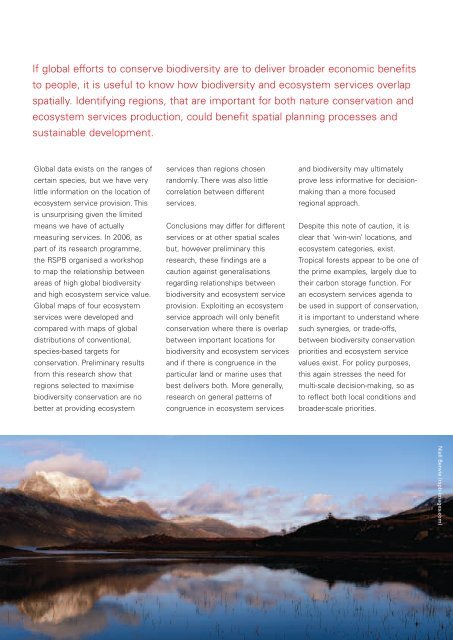Naturally, at your service: - RSPB
Naturally, at your service: - RSPB
Naturally, at your service: - RSPB
You also want an ePaper? Increase the reach of your titles
YUMPU automatically turns print PDFs into web optimized ePapers that Google loves.
If global efforts to conserve biodiversity are to deliver broader economic benefits<br />
to people, it is useful to know how biodiversity and ecosystem <strong>service</strong>s overlap<br />
sp<strong>at</strong>ially. Identifying regions, th<strong>at</strong> are important for both n<strong>at</strong>ure conserv<strong>at</strong>ion and<br />
ecosystem <strong>service</strong>s production, could benefit sp<strong>at</strong>ial planning processes and<br />
sustainable development.<br />
Global d<strong>at</strong>a exists on the ranges of<br />
certain species, but we have very<br />
little inform<strong>at</strong>ion on the loc<strong>at</strong>ion of<br />
ecosystem <strong>service</strong> provision. This<br />
is unsurprising given the limited<br />
means we have of actually<br />
measuring <strong>service</strong>s. In 2006, as<br />
part of its research programme,<br />
the <strong>RSPB</strong> organised a workshop<br />
to map the rel<strong>at</strong>ionship between<br />
areas of high global biodiversity<br />
and high ecosystem <strong>service</strong> value.<br />
Global maps of four ecosystem<br />
<strong>service</strong>s were developed and<br />
compared with maps of global<br />
distributions of conventional,<br />
species-based targets for<br />
conserv<strong>at</strong>ion. Preliminary results<br />
from this research show th<strong>at</strong><br />
regions selected to maximise<br />
biodiversity conserv<strong>at</strong>ion are no<br />
better <strong>at</strong> providing ecosystem<br />
<strong>service</strong>s than regions chosen<br />
randomly. There was also little<br />
correl<strong>at</strong>ion between different<br />
<strong>service</strong>s.<br />
Conclusions may differ for different<br />
<strong>service</strong>s or <strong>at</strong> other sp<strong>at</strong>ial scales<br />
but, however preliminary this<br />
research, these findings are a<br />
caution against generalis<strong>at</strong>ions<br />
regarding rel<strong>at</strong>ionships between<br />
biodiversity and ecosystem <strong>service</strong><br />
provision. Exploiting an ecosystem<br />
<strong>service</strong> approach will only benefit<br />
conserv<strong>at</strong>ion where there is overlap<br />
between important loc<strong>at</strong>ions for<br />
biodiversity and ecosystem <strong>service</strong>s<br />
and if there is congruence in the<br />
particular land or marine uses th<strong>at</strong><br />
best delivers both. More generally,<br />
research on general p<strong>at</strong>terns of<br />
congruence in ecosystem <strong>service</strong>s<br />
and biodiversity may ultim<strong>at</strong>ely<br />
prove less inform<strong>at</strong>ive for decisionmaking<br />
than a more focused<br />
regional approach.<br />
Despite this note of caution, it is<br />
clear th<strong>at</strong> ‘win-win’ loc<strong>at</strong>ions, and<br />
ecosystem c<strong>at</strong>egories, exist.<br />
Tropical forests appear to be one of<br />
the prime examples, largely due to<br />
their carbon storage function. For<br />
an ecosystem <strong>service</strong>s agenda to<br />
be used in support of conserv<strong>at</strong>ion,<br />
it is important to understand where<br />
such synergies, or trade-offs,<br />
between biodiversity conserv<strong>at</strong>ion<br />
priorities and ecosystem <strong>service</strong><br />
values exist. For policy purposes,<br />
this again stresses the need for<br />
multi-scale decision-making, so as<br />
to reflect both local conditions and<br />
broader-scale priorities.<br />
Niall Benvie (rspb-images.com)
















